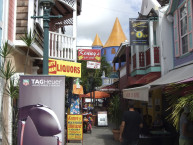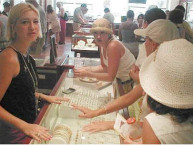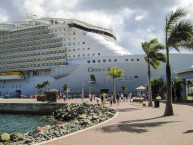Aruba
 With it’s white sandy beaches, world class diving and fabulous dining, entertainment and nightlife, Aruba is fast becoming the hottest tourist mecca in the Caribbean.
With it’s white sandy beaches, world class diving and fabulous dining, entertainment and nightlife, Aruba is fast becoming the hottest tourist mecca in the Caribbean.
Aruba is completely outside the huricane belt and with the cooling trade winds, this island is one of the most temperate islands in the Caribbean. The temperatures are just as comfortable in July as in January.
The south and west coasts have miles of pristine white beaches – some of the most beautiful in the world and many picturesque hidden bays. The island’s most famous trees are the watapana, or divi-divi trees. The rugged northeastern coast has its own beauty with Caribbean waters and secluded beaches. If you come to Aruba, take a trip to this part of the island and experience the sights and sounds of the crashing waves washing upon the jagged rocky coast.
Aruba, an island with probably the highest standard of living in the West Indies. The illiteracy rate, for example, is exceptionally low. Today tourism has become the major factor in the island’s economy with many major hotel chains setting up in Aruba. In just a few short years, Aruba has become one of the most popular vacation spots in the Caribbean, with visitor figures approaching a million annually

Popular belief links Aruba’s name with the Spanish phrase “oro huba” which means “there was gold”. In fact the Spanish did not find any gold, and regarded Aruba as “valueless”. Another possibility is that Aruba’s name comes from the Indian word “oruba” which means “well placed “. Yet another possible derivation of the name is from two Carib Indian words “ora” meaning “shell”, and “oubao” meaning “island”.
Long before the Spanish arrived, Caquetio Indians of the Arawak tribe settled on the Paraguana peninsula in Venezuela. Threatened by the Carib Indians who were extremely ferocious, they came to the Island of Aruba perhaps as long as 4000 years ago. Today, many names of towns and other geographical areas such as Turibana, Guadirikiri, Camacuri, Andicuri and Bushiri, originate from the earliest Indian chiefs and warrior settlers.
Languages:
English and Spanish are widely spoken, although the official
language is Dutch and the native language is Papiamento.
Click here to go to the Papiamento page
Shopping

Aruba is world known for it’s fine dining. The ultra modern supermarkets are over-flowing with a huge variety of foods to cater to the poly-cultural clientel. Argentinean beef is perhaps some of the tasty and flavorful in the world. The cheese counters are abundent with Dutch, French and English cheeses. The wide varieties of pastries and sweet treats will leave you speechless. What better way to enjoy a meal than with a fine wine. The selection in Aruba is second to none in the hemisphere. Supermarkets are open Monday thru Saturday 8am till 8 pm. Some are open Sunday until 1pm. US dollars are accepted as are credit cards and travelers checks. Most stores require a legal form of identification.
KANTILL REEF
Boat Dive
- 120ft
- Bottom – Drop off
- Flora – Brain & star coral
- Great for PhotographsPLONCO REEF
- Boat/drift dive
- 100ft
- Flora – Large coral formationsDANTCHI’S DELIGHT
- Boat/dive
- 100ft
- Bottom – Sloping
- Flora – Sponges, Elkhorn coral
- Great for photos & BeginersTUGBOAT WRECK
- Boat/wreck dive
- 90ft
- Bottom – Tugboat at 90ft
- Flora – Star – Brain & lettuce coral
- Great for photosPEDERNALES WRECK
- Boat dive
- 25ft
- Bottom – Wreck pieces
- Flora – Coral formations
- Execellent for BeginersANTILLA WRECK
- Access by boat only
- 54ft
- Bottom – Wreck partially exposed
- Flora – Wreck covered with sponges and corals
- Largest wreck in Caribbean, night diveCOMMANDEURS REEF
- Boat/shore/drift dive
- 90ft
- Bottom – Sloping
- Flora – Lettuce Coral formations
- Varied underwater lifeBABY BEACH
- Boat/shore drift dive
- 60ft
- Bottom – Shallow with wreck
- Flora – Elkhorn Coral, Sheet Coral
- Execellent for snorkelingSKALAHEIN
- Boat dive
- 120ft
- Bottom – Sloping
- Flora – Brain, Star, Fire
- Execellent for drift diving
Seven Wonders of Aruba
The small island of Aruba has as many diverse attractions as any one could imagine. From the enormous desert sand dunes to the lush tropical gardens of the Butterfly Farm perfect for exploring and observing the most colorful of creatures of nature – a rare opportunity for photographic memories. There is an observation tower which has been erected at the water treatment facility which empties into a two tier man-made lake, known as the large and small Bubali Bird Ponds. This has become a nesting and breeding area for more than 80 species of migratory birds such as herons, egrets, gulls, skimmers, coots, cormorants… and ducks and more – a heaven for bird watchers.
Arikok National Park
Eighteen percent of the island of Aruba is part of the Arikok National Park. The park is the habitat of several animal species found only in Aruba – including two snake species, the Aruban whiptail lizard, the Aruban burrowing owl, Aruban parakeet… among others. There were several phases of Native American occupations in Aruba, each leaving behind artifacts and evidence of the inhabitant’s presence, which are preserved in the park.
Fort Zoutman’s Museum and the William III Tower
Fort Zoutman was named after a Dutch Rear Admiral who outwitted the British during the 4th British War. The tower was located on the shoreline and was armed with four cannons – which are still on display. The Tower of Willem III was added to the Fort and it also contained Aruba’s first public clock. Fort Zoutman contained the government offices – the police department and a prison. The tower served as a lighthouse and this structure has been utilized since 1868. Today the buildings house the Museo Arubano which is a museum displaying many artifacts reminiscent of colonial times to the present day.
California Lighthouse
The old stone California lighthouse is popularly named for the off-shore wreck of the famous ship, “California.” The lighthouse has become one of Aruba’s scenic  trademarks and offers a picture perfect view of the island’s western coastline of sandy beaches. There is a restaurant nearby the lighthouse that offers fine dining at night and lunches during the day. The northwestern tip of the island is known as “Hudishibana” and has large rolling sand dunes and a rocky coral shoreline. These are named the “California Dunes”. Aruba’s desert landscape gives it image of cacti, aloe and huge gigantic hills of sand. Exploring these dunes by means of a four wheel drive jeep is a popular activity.
trademarks and offers a picture perfect view of the island’s western coastline of sandy beaches. There is a restaurant nearby the lighthouse that offers fine dining at night and lunches during the day. The northwestern tip of the island is known as “Hudishibana” and has large rolling sand dunes and a rocky coral shoreline. These are named the “California Dunes”. Aruba’s desert landscape gives it image of cacti, aloe and huge gigantic hills of sand. Exploring these dunes by means of a four wheel drive jeep is a popular activity.
The Natural Bridge
The Natural Bridge rises some 25 feet above the sea and spans a hundred feet of rock-strewn waters carved out of solid coral. It is the Caribbean area’s

highest and most dramatic coral structure. This is the island’s most photographed attraction and is located on the north east coast and is easy to drive to. This site makes for fantastic picnics or a cool swim and the bridge acts as a buffer from the crashing waves. Nearby on your drive you will pass the gold mill ruins at the tip of the Spanish Lagoon, the site of the world’s second largest desalination plant.
The Natural Pool
From horseback riding tours to 4-wheel drive jeep racing up and down the sand dunes – Aruba is exciting, varied and romantic. There is a tour along a rocky trail that leads to one of the most romantic spots on the Isle of Aruba. The Natural Pool is made up of an outcropping of rocks, forming a natural pool large enough for swimming on the northeastern coast. The rocks protect the pool from the northeastern ocean winds and rough surf. An experience right out of the Tarzan era.
History
Aruba was discovered in 1499 by the Spaniard Alonso de Ojeda.
Throughout the swashbuckling colonial era that followed, the island
had its share of visits by pirates and buccaneers. In 1636 near the
culmination of the 80 Year War between Spain and Holland, the
Dutch took possession. There was an interregnum from 1805 to
1816 during the Napoleonic Wars and the English assumed control.
In 1816 the Dutch returned.
In 1824 the greatest treasure of all was discovered – gold!
Now Aruba had its first industry and the mines yielded until it
became uneconomic and was discontinued in 1916.
But is was black gold that brought real prosperity. 1924 was probably
the most important year in the island’s history.
Two oil refineries were built; the Eagle Oil Refinery on the westside
of the island, and the Lago Oil & Transport Company on the east side
of the island.
The next industry to bring further prosperity was tourism. Cruise ships
were the main source of visitors until 1959 when the first luxury hotel
was opened. Over the years 28 additional hotels were the backbone
of the island’s economy.
During the 1950’s, the Eagle Oil Company was dismantled and ceased
to exist. On March 31, 1985 Exxon closed the refinery due to reduced
world-wide demand for oil and oversupply of refining capacity. Aruba is
seeking new approaches for the development and diversification of
its economy.
After 1986, the government has emphasized on the tourism industry
and has tripled the amount of hotel rooms.
In the last years, Aruba’s tourism has shown a constant increase.
On April 20, 1991, the Coastal Oil Company reopened the refinery.
Coupled with the booming tourism industry, it provides Aruba with
one of the highest standards of living in the Caribbean.
A variety of attractive fiscal incentives are offered to encourage
the establishment of new industrial enterprises, tourism projects
and off-shore companies.
Folklore & Traditions
The earliest settlement of the island of Aruba brought people to these shores a melange of people from the South American and European continets, and later from the Far East and other parts of the Caribbean, whose cultures have added a unique and piquant flavor to the lives of it’s inhabitants and visitors.
The why and wherefore of the island’s folklore and tradition involve the home, food, health, religion, holiday observances, celebrations, colors and sounds.
Driving around the island one may see housewives sweeping their dirt yards where plants are kept in containers. This is not for neatness or the fact that the ground is hard, but to keep the yard clear of any creepy crawly creatures that may want entrance into the home, a tradition maintained from early Indian custom.
Some believe that it is necessary to go out the same door one entered. Scientific explanations are not available, but one should try to accommodate a Guest if asked.
The origin of the following bit of folklore strategy is still a mystery: if guests stay to long or an unwanted guest needs to be encouraged to leave your home. Witness’s report that this truly works: stand a straw broom upside down against an outside wall, and within a few minutes there is an exodus of monumental proportions.
A red ribbon suspended over a doorway protects the house or place of business from evil spirits. Similarly, newborns and small children wear a chain with a red and black seed from a tropical tree which is thought to keep the “evil eye” away.
The gel from the aloe plant is well known for healing burns and cuts, healing sports injuries (we know of one football coach from the United States who buys a supply every year to make sure his receivers and quarterbacks have “good hands”). And according to older residents, one of the best agents for keeping the internal organs refreshed and clean. Many plants growing wild here fulfill their function as a healing or curing agents. A traditional and regularly used plant brewed into tea for stomach aches is made from black sage, called basora pretu (black broom), and has the medicinal properties used by pharmaceutical companies in pill or liquid form.
Fishermen test barracuda to be sure they are not poisonous by inserting a silver coin in the gills. If it turns black, the fish goes back into the sea. And if one is not certain how fresh the fish and seafood are, set it out in the sun and within a few minutes ants will appear from nowhere to feast; no ants, it’s fresh enough to eat.
The “DERA GAI” (pronounced dera guy) festivities held each June are a combination of an earlier Indian harvest celebration which was later joined to the Catholic Church feast day of St. John. While clearing the fields of old crops, huge bonfires were built over which men jumped and challenged others to the accompaniment of tall tales, food and drink. The 2-day event included burying a rooster up to his neck with a calabash (gourd) over its head which was level with the ground. Musicians would play for each blindfolded man who would dance with a lady dressed in yellow, to honor the blooms of the Kibra hacha tree, who was trying to confuse his sense of direction. Then with a 3″ stick and still blindfolded, he would have three chances to find the rooster with the crowd singing improvisational lyrics and responses. The winner received the rooster for his dinner. Today, a dummy rooster is used but the tradition of singing and dancing continues.
The tradition of “DANDE” (pronounced donday) is an end-of-the-year celebration unique to Aruba and one that has existed for over 170 years. Groups of at least seven musicians go from house to house starting right after midnight on New Year’s Eve singing a song that serenades the family with good wishes for the coming year. While the musical style and the chorus remains the same, lyrics are improvised for each family which often leads to great hilarity. The chorus, “O Dande, Aii-i-nobo”, (“A happy new year to you all”) is, according to oral history, altered from the Spanish expression “Hay un aiio nuevo” (“a new year is here”) since “an-i-nobo” does not exist in Papiamento, the language of Aruba. A typical refrain is “O Dande, benediction pa tur familia” (“blessings to all your family”) AR-i-bbo”.
The musicians play the cuatro, a 4-stringed instrument similar to the ukelele; a tambor, a drum made from small wooden barrel with goat or sheep skin ends; the wiri, a metal rasp; the raspa, a rasp made from calabash fruit; a guitar, violin, marimba and accordion. Dande continues until Epiphany, Three Kings Day, on January 6th.
Although the world gets smaller every day through communications, folklore and tradition continue to hold a culture together through fact and perhaps a touch of whimsy.
People
A mix of ancestors has produced a people of striking appearance and warm
and friendly personality.
The earliest recorded history of Aruba notes that the first inhabitants were the
peace-loving Arawak Indian tribe of the Caiquetio nation who were
farmers and fishermen.
They left behind painted petrographs on the walls and ceilings of the caves as
well as on great granite rocks at Ayo and Arikok, with the dye of the paint wood trees.
These inscriptions are well preserved but their meaning has eluded scholars
and remains a mystery still to be solved.
In recent excavations by geologists, ancient clay pottery and artifacts were discovered.
The fine craftsmanship and artistic design have been an inspiration to young Aruban
artists who are now producing contemporary pottery and other art works.
Indian ancestry is apparent in most Arubans. But they also reflect the features of
the Dutch and Spanish who settled on the island in the fifteenth and sixteenth centuries.
In the twentieth century when Aruba’s industry brought people from all corners of the
world there was a further blending of the population. Today among the more than
81,000 inhabitants there are over 40 nationalities living peacefully together like a small
United Nations.
 Carnival
Carnival
You have not lived until you have experienced the spirit of Carnival as it is celebrated in Aruba!
Carnival means weeks of events that bring you colorfully decorated floats, contagiously throbbing music, luxuriously costumed groups of celebrants of all ages, King & Queen elections, electrifying jump ups and torch light parades that wind their way through the streets at night, the Jouvert morning: the Children’s Parades and finally the Grand Parade.This has got to be the greatest party ever!
Where else can you find Antillean “tumba” music, the Calypso and steel bands of the English Caribbean, the salsa beat of Latin countries plus marching bands and a smattering of Dutch oom-pa-pa? The 2 month long celebration culminates with the all-day Grand Parade on Sunday, with everyone and everything all decked out.
Be sure to put on your shades, there’ll be an awful lot of glitter out there! Monday is an official holiday for everyone to recoup and recover!
But just when you think it is all over, there’s the Farewell Parade and the burning of Momo, indicating the end of Carnival and the beginning of Lent. Symbolically, Momo’s ashes are used on Ash Wednesday.
All in all, we think this is the perfect time for people to come visit Aruba.



